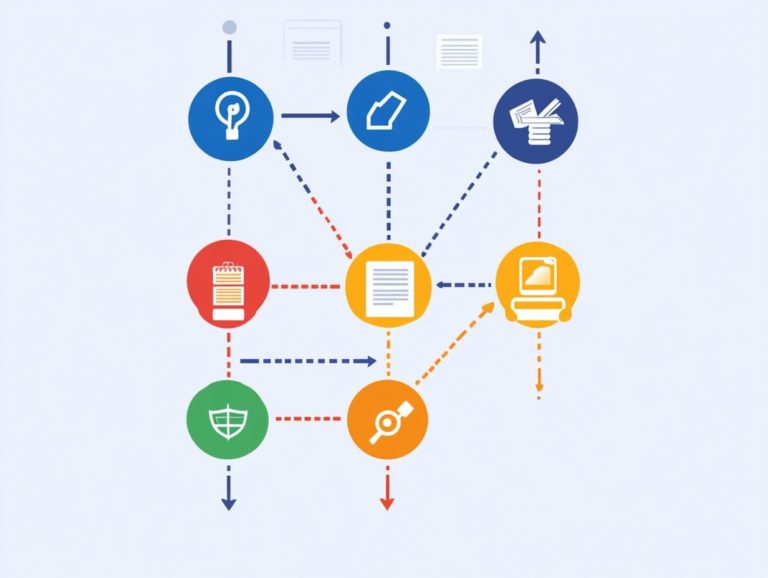Top 5 Project Management Success Stories
Project management is an art form that merges vision, strategy, and execution. It often leads to monumental achievements that redefine our world.
In this article, you ll explore five iconic projects: the Sydney Opera House, the Panama Canal, the Hoover Dam, the Golden Gate Bridge, and the Burj Khalifa.
You ll uncover the key factors that drove these projects to success and the challenges they encountered. You will also discover the innovative solutions that emerged in response.
You will explore their lasting impact on society and discover valuable lessons for project managers. Get ready to embark on an exciting journey through extraordinary triumphs in engineering and design.
Contents
- Key Takeaways:
- 1. The Sydney Opera House
- 2. The Panama Canal
- 3. The Hoover Dam
- 4. The Golden Gate Bridge
- 5. The Burj Khalifa
- What Are the Key Factors That Contributed to the Success of These Projects?
- Frequently Asked Questions
- What Are the Top 5 Project Management Success Stories?
- What Factors Contributed to These Success Stories?
- How Did Project Management Play a Crucial Role in These Achievements?
- What Lessons Can Be Learned from These Success Stories?
- How Can These Success Stories Inspire Aspiring Project Managers?
- Can These Success Stories Be Replicated in Different Industries or Projects?
Key Takeaways:

Effective project management can lead to iconic and impactful structures such as the Sydney Opera House, Panama Canal, Hoover Dam, Golden Gate Bridge, and Burj Khalifa.
Key factors for success include careful planning, strong leadership, effective communication, and adaptability to challenges.
Challenges such as budget constraints, technological limitations, and unforeseen obstacles can be overcome through creative solutions, teamwork, and perseverance.
Lessons learned from these success stories highlight the importance of risk management, flexibility, and continuous improvement in project management.
These projects have made significant contributions to society and the economy and serve as testaments to human innovation and determination.
1. The Sydney Opera House
The Sydney Opera House stands as an architectural marvel and a prime example of effective project management. It showcases the principles of careful planning, stakeholder engagement, and strategic approaches that have solidified its status as a cultural icon in Australia.
Initiated in the 1950s, this ambitious project encountered a myriad of challenges, from design conceptualization to construction complexities. Stakeholders, including government entities and local communities, played a crucial role in voicing their perspectives throughout the journey.
Essential project management tools, like Gantt charts visual tools that show project timelines and risk assessment matrices tools that help teams evaluate potential problems were employed to monitor progress and address challenges. This ensured accountability among team members.
By skillfully balancing innovative design aspirations with practical constraints, decision-makers fostered a collaborative environment. They transformed visionary ideas into reality, creating a symbol of artistic excellence.
2. The Panama Canal
The Panama Canal stands as a testament to exceptional engineering, showcasing the essence of successful project management. It wasn’t just about digging a ditch; it involved strategic approaches, careful planning, and overcoming significant operational hurdles that defined its construction and lasting impact on global trade.
This monumental endeavor revolutionized maritime navigation, linking the Atlantic and Pacific Oceans and slashing travel time for vessels. The planning phase involved intricate geographical and socio-political considerations, paving the way for innovative project management strategies that included risk assessment and active stakeholder engagement.
As the work unfolded, key performance metrics like timeline adherence, cost management, and resource allocation were crucial in tracking progress and measuring success. This enabled the team to address issues like disease outbreaks and engineering obstacles with remarkable effectiveness.
The completion of the canal was not just a feat of engineering; it was a shining example of cutting-edge methodologies and collaborative efforts that fundamentally reshaped the landscape of global trade.
3. The Hoover Dam
The Hoover Dam stands as a prime example of project success, showcasing innovative engineering and careful project management. It underscores the significance of performance metrics and accountability in achieving exceptional construction outcomes.
Throughout its planning and execution phases, the project placed a strong emphasis on establishing clear performance benchmarks. These benchmarks were essential for accurately gauging progress and efficiently allocating resources.
Teams were equipped with modern project management tools, allowing for real-time monitoring of construction milestones and budget adherence. This systematic approach fostered open communication among cross-functional teams. It ensured that every stakeholder remained aligned with the project s objectives.
Frequent updates and assessments not only strengthened accountability but also facilitated timely adjustments. This proactive stance significantly reduced the risk of delays and enhanced overall efficiency. Ultimately, this careful orchestration of efforts played a vital role in the dam’s successful completion.
4. The Golden Gate Bridge

The Golden Gate Bridge stands as a testament to engineering brilliance and adept project management. It illustrates the critical roles of stakeholder engagement, resource management, and strategic planning in crafting extraordinary project outcomes.
From its inception in the 1920s, the project faced many challenges, particularly in securing sufficient funding. This necessitated innovative financial strategies and partnerships that spanned both public and private sectors.
Engaging the local community proved essential. It fostered a sense of ownership and support that paved the way for seamless execution.
During the planning phases, extensive consultations with engineers, architects, and local businesses ensured that diverse perspectives were woven into the design and implementation processes. Effective resource management gave the team the power to navigate complex logistics, prioritize safety, and mitigate risks, leading to timely milestones.
Ultimately, the collaborative efforts and shared commitments among stakeholders shaped key project decisions. This cemented the bridge’s legacy as an engineering marvel that continues to inspire generations.
5. The Burj Khalifa
The Burj Khalifa stands as a remarkable testament to modern project management. It exemplifies the crucial roles of project visibility, stakeholder engagement, and meticulous planning in bringing to life one of the tallest structures in the world.
The path to its completion was far from simple. The construction team encountered unique challenges, particularly in logistics and resource allocation, given the monumental scale of the project.
They had to guarantee timely delivery of materials in the right quantities while contending with the dynamic nature of an evolving urban landscape.
To navigate these intricate challenges, advanced project management tools were deployed. This approach allowed the team to maintain transparency and accountability throughout the entire project lifecycle. It seamlessly coordinated efforts among various stakeholders and ensured that timelines were met without compromising quality.
What Are the Key Factors That Contributed to the Success of These Projects?
The success of iconic projects like the Hoover Dam and Golden Gate Bridge relies on a few crucial factors to consider.
Strategic project management, effective stakeholder engagement, and the consistent use of performance metrics are essential for ensuring operational efficiency throughout the project lifecycle.
These characteristics show the importance of careful planning. Involving all relevant parties from the beginning fosters cohesive decision-making.
By employing performance metrics at various stages of the projects, you gain invaluable insights. These insights allow you to measure progress and make necessary adjustments in real time.
This emphasis on adaptability, paired with a clear roadmap, ultimately lays the foundation for success in these monumental undertakings. Don t wait use these insights to adapt and succeed in your own projects!
What Were the Biggest Challenges Faced During These Projects?
Projects like the Panama Canal and the Hoover Dam faced many challenges. Logistical issues and environmental hurdles required effective tracking.
These challenges didn t just affect construction timelines; they also tested the adaptability of the teams working on such monumental endeavors.
As various stakeholders, from local communities to government entities, raised concerns about environmental impacts and resource allocation, it became crucial for project managers to implement effective tracking tools.
Such tools allowed for real-time monitoring of progress and resource usage. This enabled teams to tackle bottlenecks quickly while ensuring compliance with environmental regulations.
Consistent updates were key to maintaining open communication with stakeholders. This fostered a collaborative spirit that ultimately played a significant role in the successful completion of these engineering marvels.
How Were These Challenges Overcome?

Solving challenges during major projects relies on innovative management tools and strategic resource management. Engaging stakeholders is key for effective solutions.
By using methods like Agile and Lean, teams can adapt quickly to setbacks and work more efficiently. Effective resource allocation greatly enhances efficiency.
Keeping stakeholders updated is crucial for open communication. This cultivates a collaborative environment, allowing for real-time feedback and adjustments that minimize delays.
This multi-faceted approach not only addresses immediate issues but also builds long-term relationships that fuel sustainable success across various initiatives.
What Were the Lessons Learned from These Projects?
These landmark projects teach us valuable lessons about success and management. Strategic planning is crucial for achieving excellent performance.
By examining the outcomes and methods used, we can uncover best practices that promote teamwork and clear communication while elevating stakeholder engagement.
Common themes like adaptability in the face of challenges and a commitment to continuous improvement underscore the importance of flexibility in project management.
These insights urge future project teams to prioritize thorough risk assessments and maintain open dialogue throughout the project lifecycle. This ultimately ensures a greater likelihood of success and overall excellence in execution.
How Have These Projects Impacted Society and the Economy?
Projects like the Golden Gate Bridge and Burj Khalifa have profound social and economic impacts. They reshape local economies and improve community connections.
These monumental structures do more than stand as iconic landmarks; they catalyze job creation both during and after construction.
As tourism flourishes around these destinations, local businesses thrive when visitors flock to experience the unique offerings of these locales.
Moreover, the infrastructure improvements tied to such projects like upgraded public transport and better roads integrate these communities into a broader economic framework.
This fosters a vibrant atmosphere that promotes growth and development across various sectors, ensuring that the benefits extend far beyond the structures themselves.
What Are Some Key Takeaways for Project Managers from These Success Stories?
Draw essential insights from the success stories of historical projects. Highlight the significance of performance metrics, stakeholder engagement, and strategic management approaches to achieve project objectives.
Examine challenges and solutions to uncover valuable lessons for your future projects. As a project leader, create a flexible environment to pivot strategies in response to changing conditions.
Emphasize continuous learning and leverage feedback loops to enhance team communication and cohesion. By embracing technology, streamline processes to track progress and uphold accountability.
Integrating these best practices boosts project success rates and cultivates a culture of innovation and resilience within your teams.
Frequently Asked Questions

What Are the Top 5 Project Management Success Stories?
The top 5 project management success stories are:
- The construction of the Burj Khalifa – the tallest building in the world, completed in 2010.
- The Sydney Opera House project – completed in 1973, it has since become a famous landmark and cultural icon.
- The Panama Canal expansion project – completed in 2016, it now allows for larger ships to pass through and has greatly improved global trade.
- The Apollo 11 mission – successfully putting the first humans on the moon in 1969.
- The renovation of the Sistine Chapel – completed in 1999, preserving and restoring Michelangelo’s renowned masterpiece.
What Factors Contributed to These Success Stories?
These success stories were made possible by effective project management practices, such as:
- Detailed planning and thorough risk management
- Strong communication and collaboration among team members
- Adapting to changes and obstacles in a timely manner
- Utilizing innovative technology and techniques
- Staying within budget and meeting deadlines
- Prioritizing the needs and satisfaction of stakeholders
How Did Project Management Play a Crucial Role in These Achievements?
Project management provided a systematic approach to planning, executing, and completing complex projects. It allowed for efficient resource allocation, effective problem-solving, and strategic decision-making, all essential for successful project completion.
What Lessons Can Be Learned from These Success Stories?
Lessons from these success stories include the importance of:
- Strong project leadership and team management
- Effective risk management and contingency planning
- Clear communication and stakeholder engagement
- Adapting to changes and embracing innovation
- Continual learning and improvement throughout the project
How Can These Success Stories Inspire Aspiring Project Managers?
These success stories inspire aspiring project managers by showcasing the potential and impact of effective project management. They remind us that with the right skills and mindset, even the most complex projects can be completed successfully. They highlight the importance of perseverance, adaptability, and continuous learning in project management.
Can These Success Stories Be Replicated in Different Industries or Projects?
Yes, these success stories can inspire project managers across various industries. While every project is unique, implementing effective project management practices and learning from successful case studies can greatly increase the chances of achieving project success.
Ready to elevate your project management skills? Explore resources and lessons from these success stories today!






